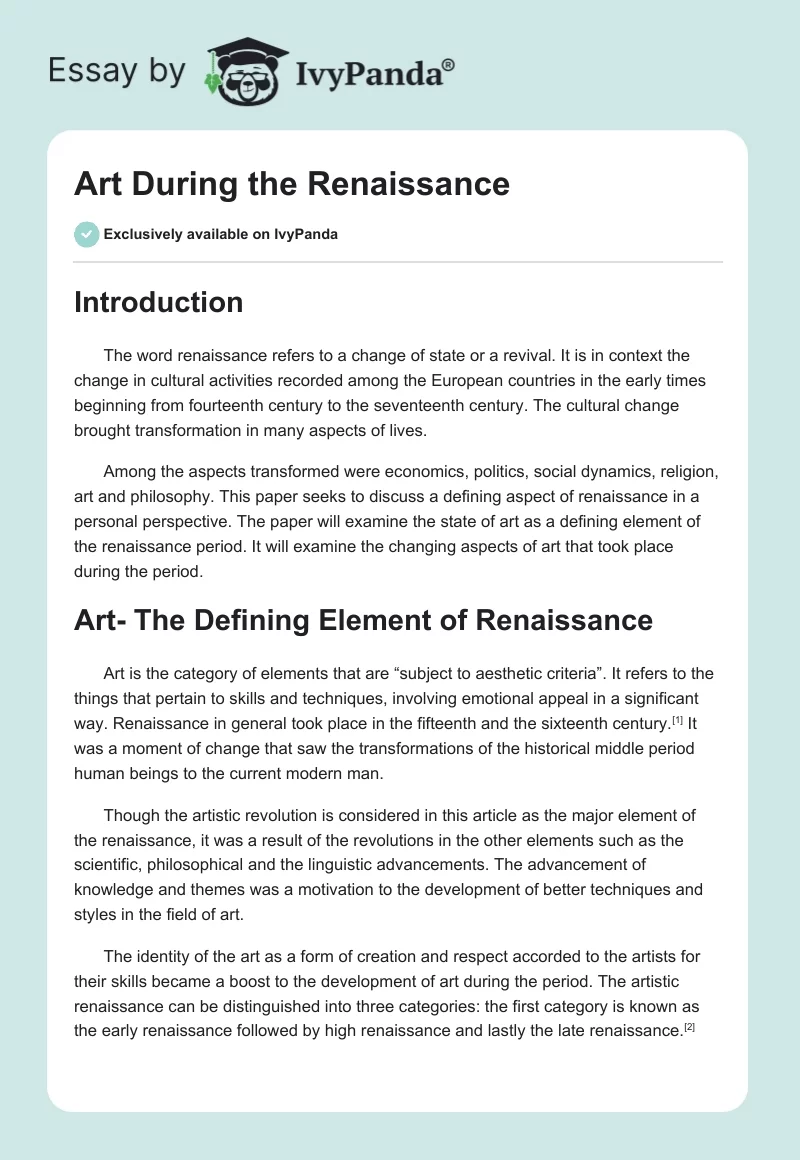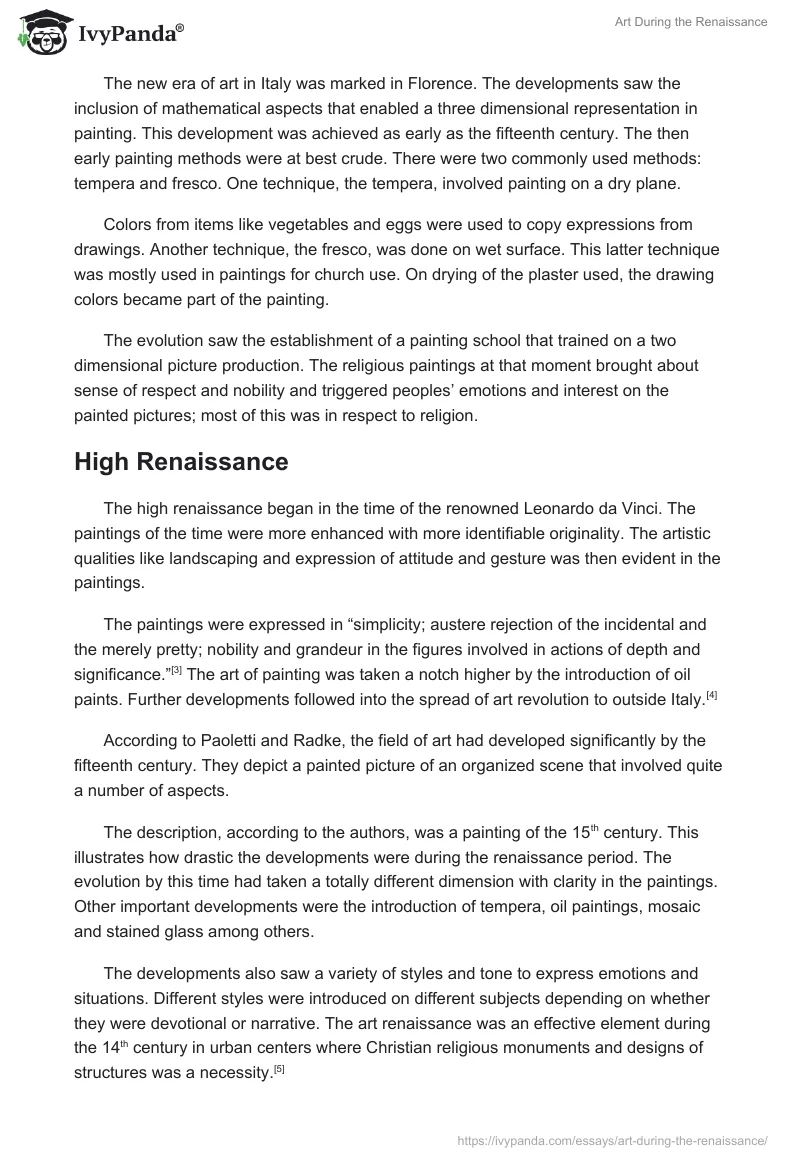Introduction
The word renaissance refers to a change of state or a revival. It is in context the change in cultural activities recorded among the European countries in the early times beginning from fourteenth century to the seventeenth century. The cultural change brought transformation in many aspects of lives.
Among the aspects transformed were economics, politics, social dynamics, religion, art and philosophy. This paper seeks to discuss a defining aspect of renaissance in a personal perspective. The paper will examine the state of art as a defining element of the renaissance period. It will examine the changing aspects of art that took place during the period.
Art- The Defining Element of Renaissance
Art is the category of elements that are “subject to aesthetic criteria”. It refers to the things that pertain to skills and techniques, involving emotional appeal in a significant way. Renaissance in general took place in the fifteenth and the sixteenth century. It was a moment of change that saw the transformations of the historical middle period human beings to the current modern man.
Though the artistic revolution is considered in this article as the major element of the renaissance, it was a result of the revolutions in the other elements such as the scientific, philosophical and the linguistic advancements. The advancement of knowledge and themes was a motivation to the development of better techniques and styles in the field of art.
The identity of the art as a form of creation and respect accorded to the artists for their skills became a boost to the development of art during the period. The artistic renaissance can be distinguished into three categories: the first category is known as the early renaissance followed by high renaissance and lastly the late renaissance.
The new era of art in Italy was marked in Florence. The developments saw the inclusion of mathematical aspects that enabled a three dimensional representation in painting. This development was achieved as early as the fifteenth century. The then early painting methods were at best crude. There were two commonly used methods: tempera and fresco. One technique, the tempera, involved painting on a dry plane.
Colors from items like vegetables and eggs were used to copy expressions from drawings. Another technique, the fresco, was done on wet surface. This latter technique was mostly used in paintings for church use. On drying of the plaster used, the drawing colors became part of the painting.
The evolution saw the establishment of a painting school that trained on a two dimensional picture production. The religious paintings at that moment brought about sense of respect and nobility and triggered peoples’ emotions and interest on the painted pictures; most of this was in respect to religion.
High Renaissance
The high renaissance began in the time of the renowned Leonardo da Vinci. The paintings of the time were more enhanced with more identifiable originality. The artistic qualities like landscaping and expression of attitude and gesture was then evident in the paintings.
The paintings were expressed in “simplicity; austere rejection of the incidental and the merely pretty; nobility and grandeur in the figures involved in actions of depth and significance.” The art of painting was taken a notch higher by the introduction of oil paints. Further developments followed into the spread of art revolution to outside Italy.
According to Paoletti and Radke, the field of art had developed significantly by the fifteenth century. They depict a painted picture of an organized scene that involved quite a number of aspects. The description, according to the authors, was a painting of the 15th century. This illustrates how drastic the developments were during the renaissance period. The evolution by this time had taken a totally different dimension with clarity in the paintings. Other important developments were the introduction of tempera, oil paintings, mosaic and stained glass among others.
The developments also saw a variety of styles and tone to express emotions and situations. Different styles were introduced on different subjects depending on whether they were devotional or narrative. The art renaissance was an effective element during the 14th century in urban centers where Christian religious monuments and designs of structures was a necessity.
According to Brotton, a study in England indicates that art and individuality were celebrated as “defining features of renaissance.” Elements like politics, science and economics have dismissed on the grounds of being irrelevant to the aspect of renaissance. Art has been accredited by appraisal words like “the pleasure of the sense and the imagination.” Art in its aspects was more identified as an element of the change than the other aspects.
During the renaissance artists represented the observable features of the world in a more precise and natural way. Though in a negatively perceived way, the artistic monuments that were put in churches were the major reason for the protestant movement that saw the revolt against the Roman Catholic Church. The Catholic Church however still used the artists to make appeals to people.
The protestant movement was perceived as a break through to real worship among Christians and the perceived freedom of worship can be attributed to the art presentations that were put in the catholic churches. Besides the religious revolution, art is still being used to pass religious information in terms of paintings even at the current time.
Graham also recounted that the patrons of renaissance in Italy competed among themselves in artistic works that, in their opinion, would give them immortality. A very important aspect about art was raised; patrons of renaissance themselves identified art as a tool to immortality.
The association of the patrons, not just of art but of the entire renaissance, to associate with art is enough credibility. The association of art to immortality can also be seen as the status that was accorded to art at that time. The interaction of these patrons with the artists accorded status not only to the artists, but to the entire field of art.
Another credit to the art aspect of renaissance is the information about Filippo Breunelleschi. Fillippo who is identified as the first great architect of renaissance was an artist. The status accorded to him and the fact that renaissance is considered to have origins in Italy is an indication that art was the origin of renaissance.
It can therefore be argued that art was the basis for the movement and a credit to art over the positive effects of the cultural movement that followed. In a probably personalized view, art was identified as a way that was used to represent God and the earthly elements that he created. Art was also used to express science for example the concepts of anatomy. The events of renaissance also led to discoveries and triggered pleasure among people.
Conclusion
Renaissance was an event of advancement in different aspects of life. It is believed to have originated in Italy as early as the 13th century. It was a continuous process categorized into three periods. The development of art as well has its origin was associated with the city of Florence in Italy.
The development of art was not an exclusive or independent aspect but it incorporated within itself aspects of mathematics. The products of the art like paintings also became significantly valuables in religion. The artists were accorded status for their work and this is an indication of how important art was. Its inclusion in scientific representation of anatomy and religious representation gives it diverse backgrounds that originate from its origin. Art can also be identified as a source of information.
It has emotional and intellectual attachments that elicit reactive actions like the religious revolution that was as a result of artistic placements in churches. Art was therefore a central element of renaissance and the other elements can be seen to have been products of the development in art.
References
Brotton, Jerry. The Renaissance: a very short introduction. New York, NY: Cengage, 2006.
Eurasia, Carrie. “Italian Renaissance Art.” The World Wide Web Virtual Library, 1999. Web.
Fitzpatrick, Anne. The Renaissance. Mankato, MN: The Creative Company, 2005.
Graham, Andrew. Renaissance. California: University of California Press, 1999.
Hay, Denys. The Italian Renaissance in its historical background. Cambridge: Cambridge, 1977.
Paoletti, John & Radke, Gary. Art in Renaissance Italy. London, UK: Laurence King, 2006.
Pioch, Nicholas. “La Renaissance: Italy.” The Public Library and Digital Archive, 2002. Web.
Putatunda, Rita. “Italian Culture: Renaissance Art and Artists.” Buzzle, 2011. Web.


